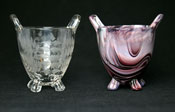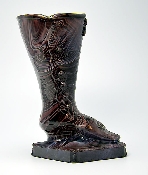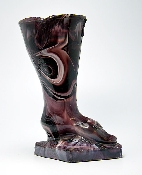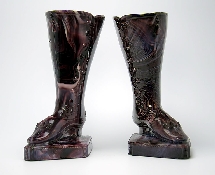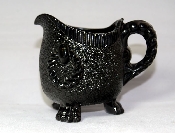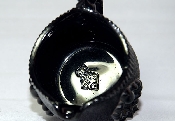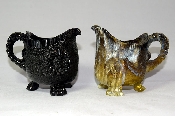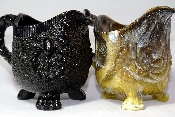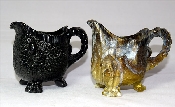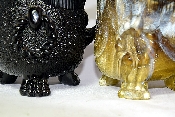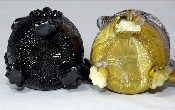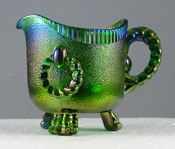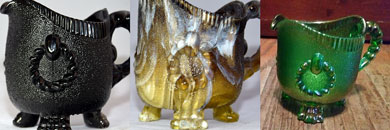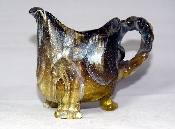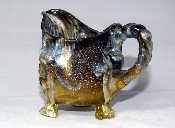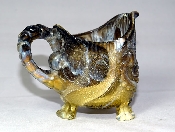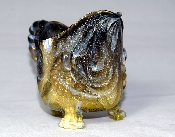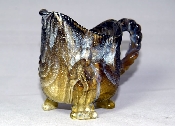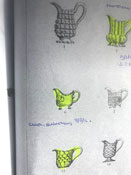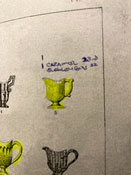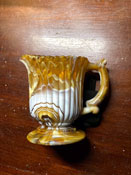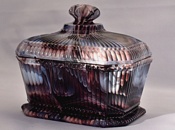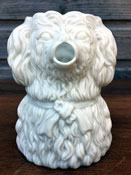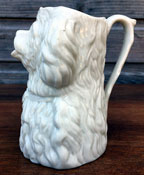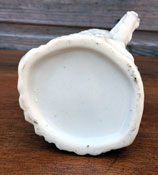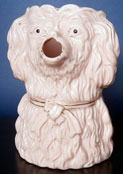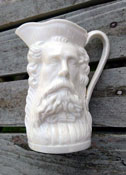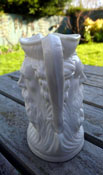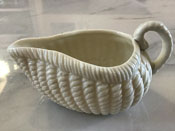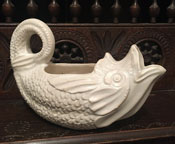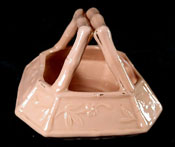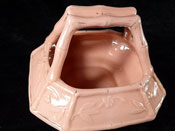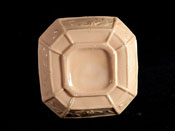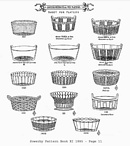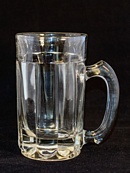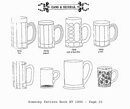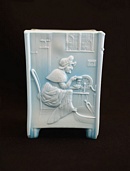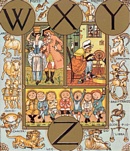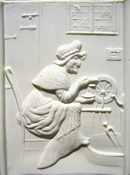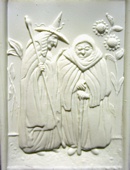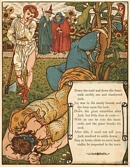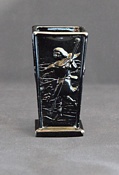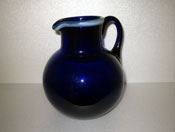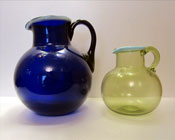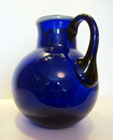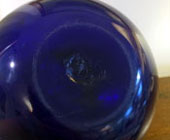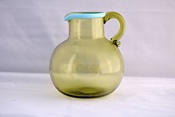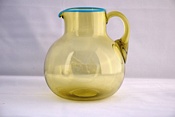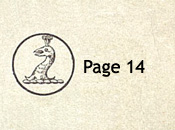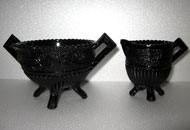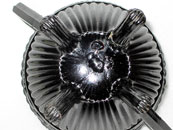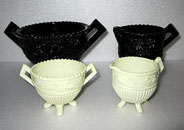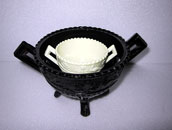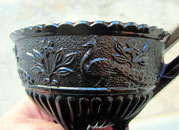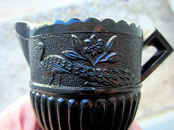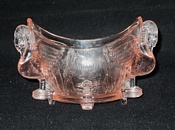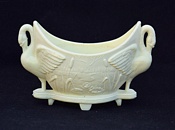Mystery / Interesting / Information / Rare Glass
Pieces of pressed glass from the Victorian period are now over 130years old. Collectors of this type of glass are lucky in that a lot of the glass is marked and there are a number of websites, publications and archives to aid them with their discoveries. But as with all types of collecting there are still a lot of items to be found that are, frankly, mysteries. Unmarked glass, glass whose use may be unknown, undiscovered facts about some of the factories producing the glass or just unusual pieces of glass. I have put together a few items that may be of interest.
Content
- INFORMATION - Sowerby Engraved Ferns
- INTERESTING - George Davidson Ladies Boot
- MYSTERY (solved) - Sowerby or French glass creamer
- MYSTERY (solved) - Sowerby Biscuit Box - attribution
- INFORMATION - Not Sowerby, dog creamer
- INTERESTING - A visit to the Ellison Flint Glass Works
- INTERESTING - Royal Society of Arts Journal letters
- RARE - Rare Sowerby glass on Antiques Roadshow
- INTERESTING - Sowerby Pattern Books, photographs?
- RARE - Sowerby patent number 2433?
- INTERESTING - Sowerby Beer Mug
- INTERESTING - Sowerby Nursery Rhyme Glass
- MYSTERY - Sowerby Cobalt Blue jug?
- INTERESTING - Sowerby Venetian glass
- MYSTERY - Sowerby black sugar and cream
- MYSTERY - Sowerby Swan trough
09/12/23 INFORMATION - Sowerby Engraved Ferns
In the 1860's the fern was a popular plant in Victorian households. Clear glass items were often engraved with numerous different decorative motifs, vines, flowers, trees, heather bloom, birds, but the fronds of ferns seemed to be a particular favourite.
The 1874 catalogue does not show any items which have been engraved after being made, any surface
decoration has been moulded. The 1880 and 1882 pattern books are mainly concerned with coloured vitro-porcelain items and show no engraved items. The 1885 pattern book shows a number of items as 'engraved' or ' cut and engraved' or 'etched and engraved' usually with fern or fern like patterns.
Engraved items were popular so, at some point, Sowerby's must have opened a department dedicated to cutting and engraving glass.
The small Sowerby posy vase pictured is pattern number 1288. Just 8cm high and usually found in opaque vitro-porcelain colours this small clear vase has been decorated with engraved ferns. After 1885 Sowerby's had mainly stopped producing small coloured opaque glass items, but were still making some of the items in clear glass, often decorating them with engraved motifs.
Small marked Sowerby engraved clear glass vases like this can still be found, this one is particularly nice.
30/09/23 INTERESTING - George Davidson Ladies Boot
Davidson's spill holder or mantel ornament in the form of a ladies boot with buttons. 6.5" (15.5cm) tall, unmarked, usually seen in purple malachite.
There is a picture on page 92 of Slack in blue Pearline, which is how we know it was made by Davidson.
This piece is usually seen with the buttons on the right hand side of the boot, a right hand boot.
There is another version with the buttons on the left hand side which is more rare.
A right and left, 'pair' can be seen in the photo below.
08/03/22 MYSTERY (solved) - Sowerby or French glass creamer
This is a Sowerby cream jug with stippled body and rope handles in black vitro-porcelain. Inside the creamer there is a lozenge which shows a design registration for 17 December 1875 - Parcel 16.
The jug is not shown in any known pattern books but the matching sugar is shown on page 48 of pattern book XI (1885), Sowerby pattern number 1129.
There are further pictures of this design and it's matching sugar on the Glass Message Board, Glass Gallery
I recently purchased a similar jug in an unusual shade of malachite glass. The two jugs look very similar until a side by side comparison is made.
The most obvious difference is that the malachite jug does not have a design lozenge. The black jug is more bulbous and slightly shorter in height.
The feet on the malachite jug extend slightly up the body of the jug and the fluting on the top rim is not so deep. The most obvious difference is the round rope handle on the left hand side the jugs, the strands of the ropes on the two jugs are twisted in opposite directions.
The intricate design on the base of both jugs is slightly different (see photo). The feet on the black jug are ground flat as is usual with Sowerby glass, the feet on the malachite jug have not been ground and are quite rough.
The two jugs came from different moulds. The malachite jug was found in France so is this a French copy of the Sowerby pattern or is it from another Sowerby mould? The original design is from 1875, if the creamer and maybe the jug were still being marketed in 1885 there may have been more than one mould for this pattern. If it is Sowerby then the malachite colour is not one I have seen before.
To further confuse matters.
There is a very interesting article about this jug on Glen & Stephen Thistlewood's excellent Carnival Glass Worldwide website.
It shows that the jug was also made by Imperial Glass in America. The article can be found HERE.
Images for comparison of the bottom and handle of the three jugs
Looking at pictures of Imperial malachite glass on Google Images it appears, although it is not marked, that the malachite jug may be Imperial 'Caramel Slag', but the malachite jug is not from the same mould as the green carnival glass jug.
It seems that we now have three different moulds and maybe three different manufacturers for these jugs.
Update March 2022
I contacted Rosalie Wenckoski at the Imperial Glass Museum in the US. Rosalie kindly put me onto Nathan Taves and Don Jennings authors of the book Slag & Marble Glass (the prominent years, 1959-1985). They stated, with a high degree of certainty, that Imperial did not make this piece in caramel slag or any slag color. At one point, IG did copy the English version and and made it in milk glass and they remembered the Save Imperial Glass Committee buying the mold when IG closed and making it in the green carnival. Thank you both for your comments.
So, still no closer to finding a maker for this jug. As the bottom of the feet have not been ground smooth, as per common Sowerby practice, I still think the jug may have been made in France. But by which company?
I will leave you with more pictures showing the malachite colour.
Update October 2022
Belgian collector Peter Tentij kindly sent me a picture of the jug in a 1897 Val St Lambert catalogue, and from the same catalogue another jug with a similar caramel colour.
So there we have it a cream jug from, not the UK or America, but from the Val St Lambert factory in Belgium. Probably a later copy from an earlier Sowerby pattern.
Sincere thanks to Peter for the information
17/02/22 MYSTERY (solved) - Sowerby Biscuit Box - attribution
I had this item listed in the Unknown Maker Gallery as a Tobacco Jar probably made by Davidson.
Since publishing the pattern book on the Sowerby Archive page, I now know this item was made by Sowerby.
It appears at the bottom of page 12 of the 1874 Pattern Book, pattern number 958 and is a Biscuit Box.
The number is contemporary with this pattern book but the Biscuit Box, being in purple malachite, would have been made after 1877.
A mystery solved.
25/11/21 INFORMATION - Not Sowerby, dog creamer
One particular item I have noticed recently, which is listed on Ebay as Sowerby Vitro Porcelain glass, is not made by Sowerby.
The item in question is a creamer or milk jug in the shape of a dog, as of today there are four on Ebay, all listed as Sowerby, see pictures below.
Like the American 'Piasa Bird' pattern which is often attributed to Sowerby, these items are were not made by the Sowerby factory and, as is often the case, one mis-attribution leads to others.
These pieces are not by Sowerby but they are interesting. As well as the dog creamer a number of other items can be found that are made from the same material and are probably from the same factory.
I can understand the confusion with vitro porcelain glass as the material from which they are made looks very similar. It has a smooth glass-like surface and 'rings' like glass but it does not seem to be made in the same way as glass, it is almost like a porcelain mixed with glass and fired. Difficult to describe but once seen easily recognisable. Items made from this material are unmarked and usually found in either white or salmon pink, sometimes with gold painted highlights. I confess, I do not know how it was made.
They are very Victorian in design and probably date from about 1880. The good thing about them is that they are very interesting and can usually be bought very cheaply.
Here are a few items on Ebay, same material, found on the same date.
A jug with two faces, a small creamer, a 'fish' creamer and a pink basket. The basket is interesting, it has a very 'Aesthetic' design, popular in the 1880's.
So, not Sowerby but maybe a good thing to start collecting.
I now have to make an confession. Many years ago someone told me the name of the company that made these items in this material, I then forgot and I have been trying to find the name ever since.
So, if anyone knows the name of the company please let me know so I can write it down this time, and update this post.
24/05/20 INTERESTING - A visit to the Ellison Flint Glass Works
An article from Graces Guide, a visit to the Ellison Flint Glass Works Gateshead, dated 1877
ELLISON FLINT GLASS WORKS, GATESHEAD.
Sowerby and Co
These works, carried on by Messrs. Sowerby and Co., are said to be the largest of the kind in England. They were established in the year 1851. The original works were founded by Mr. George Sowerby, father of the head of the present firm, in 1814.
The present buildings occupy about 54 acres of ground, and contain 8 furnaces, capable of turning out weekly upwards of 110,000 lbs. of manufactured pressed table glass. To produce these finished goods an immense quantity of minerals is required. The firm import this raw material chiefly from Fontainbleau (France), Germany, and North and South America. The cryolite which they use in the manufacture of opal glass is brought from Greenland. Altogether, the firm use upwards of 6,200 tons of raw material annually for the manufacture of the products which leave their establishment.
Several novelties in glass-making were seen at the Messrs. Sowerby's works. Articles of all sorts of design for table ware - many of them of great artistic excellence - are finished in the highest style of the trade, and are sent in large quantities into every part of the world. They vary from a common drinking glass to an elaborate and highly-ornamented Venetian flower vase.
Lately they have introduced a new article, which resembles porcelain in almost every particular, and can be made in various colours. An admirable imitation of malachite is also largely produced in articles of a very unique pattern. In addition to the glass-making works proper, Messrs. Sowerby and Co. have a foundry attached to their establishment, fitted up with turning lathes and every requisite, in which their patterns, numbering upwards of 1,500, have all been designed, cast, and finished. The firm gives employment to about 600 hands.
An article which shows some interesting things:
A large factory covering 54 acres with 8 furnaces producing a large
amount of table glass.
Sowerby's are exporting world-wide in 1877.
Vitroporcelain was patented in 1876 and had started production in 1877.
Sowerby 'art' glass was in production in 1877.
The Sowerby factory had it's own foundry and had been it's own moulds for some time.
The article can be found here: 'Graces Guide - Visit to the Works'
04/08/19 INTERESTING - Royal Society of Arts Journal letters
An interesting letter and reply from the Journal of the Royal Society of Arts in 1911
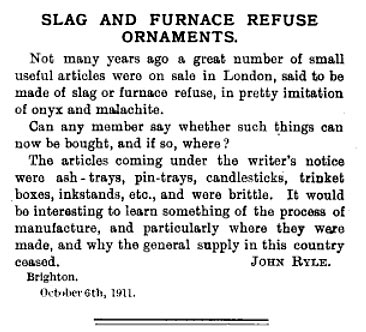
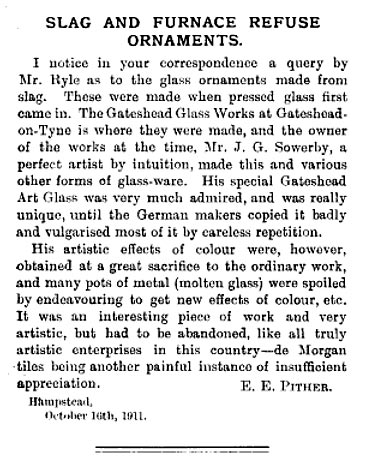
These letters are from 1911 around 25years after production of Sowerby vitro-porcelain novelties and art glass ceased. It is interesting that the original letter makes reference to the glass being made of 'slag or furnace refuse', a reference to 'slag' glass. The reply states 'these were made when pressed glass first came in', not quite true as Sowerby's first started making pressed glass in the 1850's, vitro-porcelain was patented in 1876.
Although it is not clear whether he is referring to Sowerby art glass or the vitro-porcelain novelties, it is interesting to see that he blames German makers of bad copying and for the demise of the glass. Not an opinion I have encountered before.
07/01/19 RARE - Sowerby glass on Antiques Roadshow
A very rare piece of pressed glass turned up on the Antiques Roadshow at Hartland Abbey, Devon in 2012 - see the excerpt below.
Three patterns for these 'tiles' are shown on page 11 in Sowerby Pattern Book IX June 1882. The tile on the show is the first one that has ever been found intact. A rare piece indeed.
11/02/18 INTERESTING - Sowerby Pattern Books, photographs?
Sowerby's used different lithographers and printers for their pattern books. For the known pattern books between 1870 and 1885 these details are known:
1874
No pattern book number
Additional Patterns for May 1874
Printers - Sketched and Lithographed by Maclure & Macdonald, Lithographers to the Queen, 37 Walbrook, London
1880/1881
Pattern Book VIII (8)
Vitro-Porcelain Etc
Printers - Newbery & Wilday, 5 Castle St, Holborn, London
1882
Pattern Book IX (9)
Pattern Book of Fancy Goods
Printers - R. Robinson & Co, Newcastle
1885
Pattern Book XI (11)
Illustrated Pattern Book (Pages 1 – 40)
Illustrated Pattern Book (Pages 41 – 75, Supplement Pages 76 - 81)
Illustrated Pattern Book, Continuation (Index, Continuation Pages 82 – 107)
Printers - R. Robinson & Co, Newcastle
This was a large catalogue, comprising 107 pages with addendums. A snippet from the Pottery Gazette, 1st Oct 1887 shows why:
'The company bear their connection (sic), both at home and abroad, to preserve their book XI, as the New Edition, which has been in hand many months, comprising Eighty Pages, has been entirely destroyed – Stones and Drawings – in the late fire at their printers, Messrs. Robinson's Newcastle-on-Tyne. An Addenda to the Book XI will be produced shortly, during which period they will enclose free, in any Indent, Patterns suited to the respective markets.'
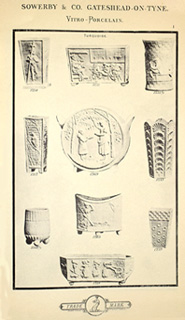
Pattern book VIII is interesting in that it appears to show that Sowerby's may have been trying to use photographs as illustrations. The full pattern book can be found here Pattern Book VIII
The pattern book illustrated here is in black and white but the original catalogue was in colour. It appears Sowerby's were keen to show off the colours of their new Vitro-Porcelain range, with a coloured sample sheet showing articles from their Patent Queen's Ivory range appearing as a suppliment to the Pottery Gazette in November 1879.
A number of lithographic techniques were in use at the time so it is difficult to be sure but the items on the first page are illustrated differently to the rest of the catalogue, they appear to be photographed, while the rest are elegantly hand drawn and coloured.
It would not be suprising if the enterprising JG Sowerby was trying to use the new, at the time, medium of photography to illustrate his pattern books. Unfortunately it looks like he may have been having another problem with printers as it appears, Newbery & Wilday, of 5 Castle St, Holborn seemed to be in trouble in 1879 as an item is The London Gazette of May 27 1879 attests:
The Bankruptcy Act, 1869.
In the London Bankruptcy Court.
In the Matter of Proceedings for Liquidation by Arrangement or Composition with Creditors, instituted by Charles Harry Littleton Wilday and Rowland Lockyer Cox, of 5, Castle-street, Holborn, in the county of Middlesex, Lithographers, Chromo-Lithographers, and Printers, carrying on business in partnership under the style or firm, of Wilday and Co., the said Charles Harry Littleton Wilday residing at 3, Cambridge-street, - Edgware-road, in the same county, and the said Rowland Lockyer Cox residing at 179, Camden-road, in the same county, the said Charles Harry Littleton Wilday having formerly carried on business in partnership with Robert Newbery, at 5, Castle-street aforesaid, as Lithographers, Chromo - Lithographers, and Printers, under the style or firm of Newbery and Wilday.
NOTICE is hereby given, that a First General Meeting of the creditors of the above-named Charles Harry Littleton Wilday has been- summoned to be held at the offices of Messrs. Lawrance, Plews, and Baker, No. 14, Old Jewry-chambers, in the city of London, on the 12th day of June, 1879, at four o'clock in the afternoon precisely.—
Dated this 17th day of May, 1879.
LAWRANCE, PLEWS, and BAKER, 14, Old Jewry-chambers, London, Solicitors for the said Charles Harry Littleton Wilday.
Maybe this catalogue was printed just in time. Whatever the problems Sowerby's did not use photographs in their pattern books again until the 1940s, relying on black and white line drawings for their product catalogues until then.
Another unusual piece of Sowerby glass which I think may have been made using patent number 2433
Diameter 13cm, height 5cm, illustrated in Sowerby pattern book XI 1885 Page 11 pattern number 1035. Page 11 has heading of: BUTTERS MIDDLES & c FOR PLATERS, SHEET FOR PLATERS, presumably this is a dish for butter?
The outside ribs of the dish are blue translucent glass moulded onto the outside of the clear glass. The blue decoration is not stained or flashed.
The bottom (inside) of the dish is marked SOWERBY'S PATENT
This refers to "Patent No. 2433 of 15 September 1871 for Ornamenting pressed glass with designs in glass of a different colour" which was the first patent registered by John George Sowerby after entering the firm in 1871.
The patent has been discussed on the Glass Message Board: 'A Patent for adding separate coloured glass ornamentation onto pressed glass'
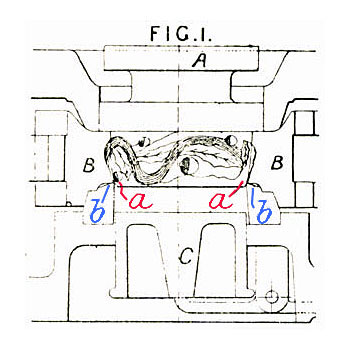
Patent 2433 text:
The outer surfaces of vases and other articles made of pressed glass are ornamented with designs in glass of a different colour to that forming the body of the article. The ornament is formed in a suitable mould B having a counter balanced false bottom C and a plunger A; the plunger and mould have corresponding bevelled edges a, b, by which all surplus metal is cut off from the casting. Directly the ornament is pressed the section of the mould containing it is fitted in the mould in which the article is to be pressed, this mould being constructed to receive it in the requisite position for ornamenting the article. The fused metal is then run into the mould and pressed to shape, during which operation the ornament becomes incorporated with the surface of the article. The ornament may be made in sections in one or several moulds.
If I understand this correctly, the outside colour (blue) is pressed in a mould, the bevelled edges on the mould cut off the excess glass. This mould is then fitted inside another mould into which the clear glass is poured and moulded to produce the 2 coloured article.
This way of moulding the glass seems to have left a rough bottom edge on the glass as this piece, like the Davidson piece in the article above has had its bottom ground flat.
The original patent was registered in 1871, this item does not carry a Sowerby trade mark (first used in 1876) or design registration mark (first used by Sowerby in Feb 1872), so it may have been made at this early date. The design appears in the 1885 catalogue, pg11 pattern number 1035. 1035 is an early pattern number so this design was from an earlier date but still being used in 1885.
This technique produces a result very similar to a glass which has been 'stained'. Staining glass is described as: "A process of coating a piece of glass with a chemical whose true color is developed by heat. This is the least expensive way of coloring glass. The staining material is painted on the annealed [cooled] article with a brush wherever the decorative effect is desired. It is then fired on for permanency at which time the glass assumes the desired colour." The differences between cased, flashed and stained can be found 'HERE'
Staining was frequently used by Bohemian and American glasshouses in the latter half of the century, often combined with acid-etched or engraved decoration.
Very few pieces have been identified so the Sowerby process may not have been a commercial success, being complicated and time consuming. If this does date from 1871/2 it would make it one of the earliest pieces of 'marked' Sowerby glass.
Not my usual area of collecting but, two things close to my heart, I had to buy it. Probably made in the thousands but rare now.
The mug has a Sowerby trade mark on the bottom and a VR and crown with a Weights and Measures mark of 323 for Gateshead.
At 16 cm tall, the mug is heavy, 1Kg (just over 2lb 5oz) empty and 1.6KG (just over 3lg 8oz) full, so a large lump of glass.
Mugs are illustrated in Sowerby Pattern Books XI of 1885 and XV of 1895, one pictured is similar but has a slightly different handle,
so I suggest with the VR mark this one was made sometime between 1885 and 1901.
Interestingly both catalogues list the mugs as "seidels", which searching on Google is an old word for 'a large glass for beer".
Cheers, mines a pint.
Most of the figures depicted on Sowerby Nursery Rhyme pieces are based on designs by Walter Crane. Illustrations can be found in 'The Baby's Opera', 'An Alphabet of Old Friends' or
'The Sleeping Beauty Picture Book' but there are a couple of designs that have not been attributed.
A spill vase with Cross Patch is from 'An Alphabet of Old Friends' on the WXYZ page:
Cross Patch,
Draw the latch,
Sit by the fire and spin:
Take a cup
And drink it up,
Then call the neighbours in.
You can just see the 'neighbours' at the window on the spill vase.
The other side of the vase has two old ladies with sunflowers in the background. One looks like a witch with a staff and snakes in her hat, the other with a walking stick and pebble glasses. It looks like a Crane drawing and I have been trying to find out where it comes from for some time. I have finally found it!
The drawing is by Crane and is in Jack and the Beanstalk (illustrated by Walter Crane) London: George Routledge and Sons, 1875. Please see the picture above.
Another, so far, unknown illustration can be found on this Sowerby spill vase. It depicts a shepherd with a crook on one side and a soldier? with a pike on the other. This seems to be generally known as a 'Good Shepherd' vase, but the illustrations are still to be attributed.
A large Cobalt/Bristol Blue coloured jug which is possibly by Sowerby. I have seen Sowerby pressed items in a similar colour. British Glass 1800-1914 by Charles R. Hajdamach
shows a similar jug (pg 256, Plate 23), which is 'possibly' Sowerby. The jug has a translucent white rim and is 195mm tall, size is shown against a 130mm Venetian jug in picture 2.
Very similar in design to the Sowerby Venetian jugs, but this jug does not have a ground smooth pontil.
Is this jug by Sowerby?
More of an observation than a mystery. Most of Sowerby's output was pressed/mould blown glass but between 1877 and 1883 they produced a line of hand blown Venetian type glass.
Shown here are two Sowerby Venetian jugs. Both are the same size and have the same smooth ground pontil. The jug on the left has a thick blue rim and a curl
on the bottom of the handle as shown in the 1880/1 pattern book page 14. But there are distinct differences between the two jugs. The green glass is different, the
jug on the right is more yellow in colour and reacts to UV light, the left jug with the 'looped' handle does not react, suggesting a different mix of glass.
The blue rims are different, the jug on the right has a rim that is darker and thinner. The most obvious difference is the way the handles are attached.
The fourth picture shows a Venetian footed flask with the same handle.
I believe they are both Sowerby Venetian, I have seen a couple of the
'looped' handle pieces with broken loops, so perhaps the design was
changed.
Unusual sugar and cream in jet glass. Both are unmarked but bear a striking resemblance to Sowerby pattern number 1350. The difference is the size. The black items are 90mm tall whereas the pattern 1350 items are 60mm tall. I have included pictures of pattern 1350 in Queensware for size comparison. The background behind the peacocks in the decoration is stippled but apart from that the decoration is very similar. I assume these are Sowerby, the moulding and pressing is very good.
The swan vase on the left is unmarked and is different to the Queensware version on the right. (click thumbnails for larger images)
Most of the swans you see are like the Queensware version, even the version made in carnival glass from the 1920's onwards is from the same, older mould.
This pink version is different, there are no gaps between the body of the vase and the neck and feet of the swans, the overall design is not so well defined and there is no Sowerby mark.
The pink colour suggests it was probably made later than the originals, perhaps in the 1930's?
Cyril Manleys book, Decorative Victorian Glass (page 104), shows a similar pink swan vase.
Is this a piece of Sowerby glass or a copy from another manufacturer?
Any information or comments on these items would be appreciated, please use the Contact form

